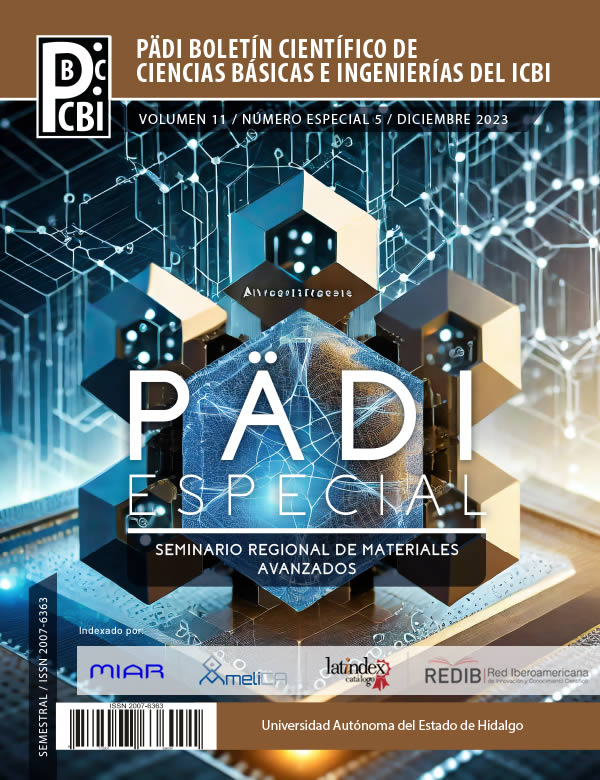Removal of fluoride ions with clinoptilolite and hydroxyapatite modified with iron
Abstract
The contamination of water by the presence of fluoride ions is an environmental and health problem in Mexico and the adsorption process with low-cost adsorbent materials such as natural zeolite and hydroxyapatite have been used in the adsorption process due to few risks. environmental conditions that imply its use. In the present work, hydroxyapatite was synthesized and Clinoptilolite-type natural zeolite was used, both materials were conditioned with iron oxide species; all materials were characterized by XRD, SEM and FTIR. In the adsorption studies, all the materials were tested in the removal of high and low concentrations of fluorine ions, obtaining very favorable results (90% conversions) for hydroxyapatite, with which the formation of fluorapatite was demonstrated, verifying the chemical adsorption of the contaminant and not so with natural zeolite, where lower removal percentages were obtained with physical adsorption.
Downloads
References
Antonio. M., Gutiérrez-Arzaluz M., Caballero-Dorantes C.A., Torres-Rodríguez M., Mugica-Álvarez V. (2022). Capacidad de adsorción de la hidroxiapatita. Revista Tendencias en Docencia e Investigación en Química 2022, Año 8.
DOF-Diario Oficial de la Federación. NORMA Oficial Mexicana. NOM-127-SSA1-2021. Agua para uso y consumo humano. Límites permisibles de la calidad del agua.
Díaz-Guzmán, D., Legorreta-García, F., Pérez-González, N.K., Flores-Zamora, M.I., Vargas-Ramírez, M., Reyes-Cruz, V.E. (2020). ¿Heulandita o Clinoptilolita? Identificación de dos zeolitas naturales isoestructurales. Tópicos de Investigación en Ciencias de la Tierra y Materiales, 7(7) 79-84.
Galicia, L., Molina, N., Oropeza, A., Gaona, E., & Juárez, L. (2011). Análisis de la concentración de fluoruro en agua potable de la delegación Tláhuac, Ciudad de México. Rev. Int. Contam. Ambient, 27(4), 283–289.
García, D.M. y Velázquez, M.C. (2004). Zeolitas de Oaxaca: Características Mineralógicas y Morfológicas. Oaxaca.
Gómez-Hortigüela, L., Pérez-Pariente, J., & Díaz, I. (2014). Materiales compuestos de zeolita-hidroxiapatita para la eliminación de fluoruro del agua potable. Anales de la Real Sociedad Española de Química, 4, 276.
Gonzalez, I. A. (2012). Estudio de la adsorción de flúor sobre un material formado de roca fosfórica con precipitados de hidroxiapatita en su superficie. Santiago de Querétaro: CIDETEQ.
Gutiérrez, M. y Alarcón-Herrera, M.T. (2022). Fluoruro en aguas subterráneas de la región Centro-Norte de México y su posible origen. Rev. Int. Contam. Ambie. 38, 389-397.
Jiménez-Flores, Y., Suárez-Quezada, M., Rojas-Trigos, J.B., Suárez, V., Mantilla, A. (2017). Sol–gel synthesis of Tb-doped hydroxyapatite with high performance as photocatalyst for 2, 4 dichlorophenoxyacetic acid mineralization. J. Chem. Technol. Biotechnol. 92, 1521–1530.
Jing Ji, F. L. (2015). (Vinylidene fluoride) (PVDF) membranes for fluid separation, Reactive and Functional Polymers.
Jeong Y., Fan M., Singh S., Chuangd C., Saha B., Leeuwenb J.H. (2007). Evaluation of iron oxide and aluminum oxide as potential arsenic(V) adsorbents. Chemical Engineering and Processing, 46, 1030–1039
Marín N., Pareja, D. M. (2008). Synthesis and characterization of microporous hydroxyapatite, comparison with a commercial product. Rev. Fac. Ing. Univ. Antioquia N.° 43, 67-76.
Medellin-Castillo, N.A., Leyva-Ramos, R., Padilla-Ortega, E., Perez, R.O., Flores-Cano, J.V., Berber-Mendoza, M.S. (2014). Adsorption capacity of bone char for removing fluoride from water solution. Role of hydroxyapatite content, adsorption mechanism and competing anions, J. Ind. Eng. Chem. 20, 4014-4021.
Montes-Luna A. de J., Fuentes-López N. C., Perera-Mercado Y. A, Pérez-Camacho O., Castruita-de León G., García-Rodríguez S. P., García-Zamora M. (2014). Caracterización de clinoptilolita natural y modificada con Ca2+ por distintos métodos físico-químicos para su posible aplicación en procesos de separación de gases. Superficies y Vacío 28(1) 5-11.
Moreno, A. R. (10 de 06 de 2011). Mailxmail.com. Obtenido de Mailxmail.com: http://www.mailxmail.com/curso-agua-tratamientos-1-2/procesos-quimicos-precipitacion-coagulacion-floculacion
Orellana-Centeno, J. E., & Morales-Castillo, V. (2019). Fluorosis dental: ¿un problema estético o sistémico? Salud y administración, 6(16), 71–75.
Ostroumov F. M., Ortiz H. L. E., Corona C. P. (2017). Zeolitas de México: diversidad mineralógica y aplicaciones. Sociedad Mexicana de Mineralogía A.C.: http://www.geocities.ws/smexmineralogia/zeolitas.hm
Palacios, P. R., De Los Santos Valladares, L., Bustamante, A., & González, J. (2012). ESTUDIO DE LA DESHIDROXILACIÓN EN EL ÓXIDO FÉRRICO HIDRATADO DENOMINADO LIMONITA. Revista de la Sociedad Química del Perú, 198-207.
Ramos, Q., Armienta, M. A., Aguayo, A., Cruz, O. (2021). Evaluation of the interactions of arsenic (As), boron (B), and lead (Pb) from geothermal production wells with agricultural soils. Ecotoxicology and Environmental Safety, 211(111843).
Rangel-Contreras Verónica, Gutiérrez-Arzaluz Mirella, Torres-Rodríguez Miguel, Mugica-Álvarez Violeta. (2021). Capacidad de adsorción de un material híbrido en la remoción del ion fluoruro. Revista Tendencias en Docencia e Investigación en Química 2021, Año 7.
Rojas-Trigos, J.B., Jiménez-Flores, Y., Suárez, V., Suárez-Quezada., Nogal, U. (2018). Sol-Gel Synthesis of calcium-deficient Hydroxyapatite: Influence of the pH behaviour during Synthesis on the Structural, Chemical composition and Physical properties. Powder Technology 5, 79-96.
Scheverin, V.N., Horst, M.F., Lassalle, V.L. (2022). Novel hydroxyapatite-biomass nanocomposites for fluoride adsorption. Results in Engineering, 16,100648.
Tejada-Tovar, C., Villabona-Ortiz, N., & Garcés-Jaraba, L. (2015). Adsorción de metales pesados en aguas residuales usando materiales de origen biológico. TecnoLógicas, 18(34), 109.
Wang, X., Nguyen, A.V. (2016). Characterisation of electrokinetic properties of clinoptilolite before and after activation by sulphuric acid for treating CSG wáter. Microporous and Mesoporous Materials. 220, 175-182.
Copyright (c) 2023 Mirella Gutiérrez-Arzaluz, Carlos Alberto Caballero Dorantes, Verónica Rangel Contreras, Violeta Mugica Álvarez, Lilia Fernández Sánchez, Miguel Torres Rodríguez

This work is licensed under a Creative Commons Attribution-NonCommercial-NoDerivatives 4.0 International License.













